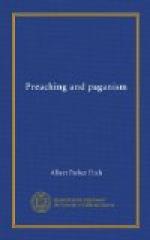“I suppose that what has given to the Old and New Testament Scriptures their enduring hold over the minds and consciences of men has been their extraordinary humanity. They contain so many vivid and accurate recitals of typical human experience, portrayed with self-verifying insight and interpreted with consummate understanding of the issues of the heart. And since it is true, as Goethe said, ’That while mankind is always progressing man himself remains ever the same,’ and we are not essentially different from the folk who lived a hundred generations ago under the sunny Palestinian sky, we read these ancient tales and find in them a mirror which reflects the lineaments of our own time. For instance,...”
Then the sermonizer proceeds to relate some famous Bible story, resolving its naive Semitic theophanies, its pictorial narration, its primitive morality, into the terms of contemporary ethical or political or economic principles. Take, for instance, the account of the miracle of Moses and the Burning Bush. The preacher will point out that Moses saw a bush that burned and burned and that, unlike most furze bushes of those upland pastures which were ignited by the hot Syrian sun, was not consumed. It was this enduring quality of the bush that interested him. Thus Moses showed the first characteristic of genius, namely, capacity for accurate and discriminating observation. And he coupled this with the scientific habit of mind. For he said, “I will now turn aside and see why!” Thus did he propose to pierce behind the event to the cause of the event, behind the movement to the principle of the movement. What a modern man this Moses was! It seems almost too good to be true!
But as yet we have merely scratched the surface of the story. For he took his shoes from off his feet when he inspected this new phenomenon, feeling instinctively that he was on holy ground. Thus there mingled with his scientific curiosity the second great quality of genius, which is reverence. There was no complacency here but an approach to life at once eager and humble; keen yet teachable and mild. And now behold what happens! As a result of this combination of qualities there came to Moses the vision of what he might do to lead his oppressed countrymen out of their industrial bondage. Whereupon he displayed the typical human reaction and cried, “Who am I, that I should go unto Pharoah or that I should




